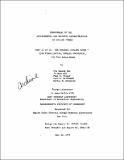| dc.contributor.author | Hon, Pou Cheong | |
| dc.date.accessioned | 2005-09-15T14:51:26Z | |
| dc.date.available | 2005-09-15T14:51:26Z | |
| dc.date.issued | 1974 | |
| dc.identifier.other | 01482817 | |
| dc.identifier.uri | http://hdl.handle.net/1721.1/27271 | |
| dc.description | Improvement of the environmental and economic characteristics of cooling towers, pt.2 | en |
| dc.description.abstract | The concept of periodic towers is to have sheet metal discs partially
submerged in hot, power plant condenser effluent. As the discs rotate,
local sections of the discs alternately absorb heat from the effluent and
discharge heat to the air. The means of heat transfer on the air side can
be either evaporative and/or convective, depending upon the amount of effluent
carried into the air side on the surface of the plates. An oil layer,
floated on the water's surface, has been shown to be effective in eliminating
water carry-over to the air side.
The advantages of the periodic tower lie in the low cost of the discs
and the ability to operate dry. A periodic tower is significantly less
expensive than a conventional dry tower fabricated with finned tubes. Further,
with the capacity of being operated wet, the high capacity losses incurred
during warm months by finned tube towers can be eliminated.
The effort to evaluate periodic cooling towers has been a three-pronged
thrust:
1) A full scale model of a periodic heat exchanger was designed and is
being built to optimize the overall performance and determine the economic
competitiveness of this new form of heat exchanger. In the periodic exchanger
cooling air is forced over the top portion of a long horizontal row of circular
discs slowly rotating in a hot water bath. This large model, over twenty-five
feet long and ten feet high with a two and one half by one foot test section,
will provide actual test data to verify previous performance optimization
calculations and allow for research and development to continue on many design
details for this new concept.
2) Disc Ribbing - Roughened Surfaces
An existing computer design routine for optimizing periodic cooling towers
has been modified by increasing the number of variables from 5 to 8. This
was done to account for the effects of roughened surfaces on heat exchanger performance. The modified optimum computer design program yields a
periodic tower configuration having the lowest incremental cost for power
operation, but it is impractical because the optimized rib heights are smaller
than the oil film clinging to the discs. Taking into account the effect of the coating oil thickness on the surfaces, sensitivity studies on the
influences of the roughened surfaces on the incremental cost have been made.
A specific 5 ft. diameter roughened surface heat exchanger yields a 15 to
20% savings of capital and incremental cost over a smooth heat exchanger of
the same diameter. This economically warrants the use of roughened rather
than smooth surfaces for periodic heat exchangers.
3) Flow visualization tests indicate that the mixing of water in the
periodic exchanger trough is strongly dependent upon both the water's inlet
and outlet points, and the rotational direction of the plates. Various
mixing currents in the trough for different geometries have been observed by
use of dye injection. Silicone oils, because of their lower vapor pressure
and subsequent low rate of evaporation, appear to be superior to petroleum
based oils. | en |
| dc.description.sponsorship | Empire State Electric Energy Research Corporation, New York | en |
| dc.format.extent | 3507708 bytes | |
| dc.format.mimetype | application/pdf | |
| dc.language.iso | en_US | en |
| dc.publisher | MIT Energy Lab | en |
| dc.relation.ispartofseries | MIT-EL | en |
| dc.relation.ispartofseries | 74-008 | en |
| dc.subject | Cooling towers | en |
| dc.subject | Heat exchangers | en |
| dc.subject | Fluid dynamics | en |
| dc.title | The periodic cooling tower - flow visualization, surface roughening, and full scale model | en |
| dc.type | Technical Report | en |
